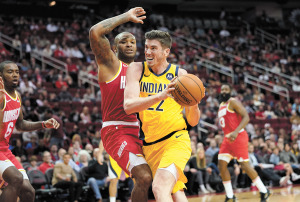Subscriber Benefit
As a subscriber you can listen to articles at work, in the car, or while you work out. Subscribe Now The days following the NBA draft offer a comforting breeze. The teams all believe they got what they were looking for, the players have achieved a lifelong dream, and fans whose perspectives have been slanted by highlight videos are confident next season will bring improvement.
The days following the NBA draft offer a comforting breeze. The teams all believe they got what they were looking for, the players have achieved a lifelong dream, and fans whose perspectives have been slanted by highlight videos are confident next season will bring improvement.
The storms come later.
The Pacers came out of the June 22 hiring spree with four new employees. Jarace Walker, taken ninth overall, will likely have a meaningful role on next season’s team, either as a starter or rotation reserve. Ben Sheppard, selected 26th, will have a guaranteed contract and a place on the roster. Two second-round picks, Mojave King (47) and Isaiah Wong (55), face serious headwinds, however. King will play at least another season elsewhere, presumably overseas, to gain more experience, but the Pacers will retain his rights.
Reality of one kind or another will set in as time goes on, but for now, let everyone enjoy their hat-donning photo ops and family celebrations and press conferences. It’s a great accomplishment to be one of 60 players in the world drafted. Fifty years from now, no matter what transpires, King and Wong can at least tell their grandchildren about it. Hopefully, it impresses the kids.
The likelihood that they can tell their grandkids they actually played in an NBA game, however, is slim. Sorry to say that, but the odds are what they are. For the majority of drafted players, it’s a chilling truth. With only 12 active roster spots per team, and with many careers lasting 10 or more years, job openings are scarce. With another batch of newcomers available every year, a high rate of turnover is inevitable.
The draft is a June version of Christmas. Teams engage in worldwide shopping expeditions, then pick what they like best out of what’s still available on the shelf when their turn arrives. Everyone is excited about the newly unwrapped gift at first, but within a year or two, it’s often broken, discarded or forgotten. Newer gifts have caught their eye.
Take Chris Duarte, for example. The Pacers did, with the 13th overall selection in 2021. He was a lottery pick, which carries a special cache because those players go to teams that failed to make the playoffs and are in desperate need of improvement. General managers who miss on those selections tend to have short shelf lives of their own.
Duarte stood out in summer league play and in the preseason, showing a special knack for hitting buzzer-beating shots, and earned a spot in the starting lineup for his NBA debut in Charlotte. He was the first Pacer to accomplish that in 20 years, and he didn’t blink. He scored 27 points, a franchise scoring record for a rookie’s debut.
He went on to score in double figures in his first nine games, prompting talk of a possible Rookie of the Year award. NBA superstar Kevin Durant was among those singing his praises—“I like him. I like him a lot”—and it was widely assumed the Pacers had their shooting guard of the future.
But then, reality. Duarte sat out 27 games that season with injuries, including the final 12. Still, he averaged 13.1 points (Reggie Miller averaged 10 as a rookie) and was voted to the second all-rookie team. His slide continued this past season, however. He sat out 36 games with injuries, and his shooting stats declined across the board, although he did score 30 points in an early-season game at Brooklyn and had 25 against Memphis.

He soared early, but his career has been injury-plagued. He now faces competition at guard from younger teammates. (AP photo)
Since Duarte’s rookie splash, the Pacers have added fresher faces at his position, including last year’s lottery pick, Bennedict Mathurin, who was a first team all-rookie selection. They also have added Buddy Hield and Aaron Nesmith—two former lottery picks acquired in trades—and now last week’s first-round pick, Ben Sheppard, has joined the mix. That’s a quantifiable logjam at the wing positions. Duarte is certainly capable of resurrecting his career if he can stay healthy, but he’s also taking on the pallor of expendability. After just two seasons.
This isn’t all that unusual in the NBA. As President of Basketball Operations Kevin Pritchard has stated, sometimes you have no choice but to cannibalize your roster with all the opportunities given to improve it. And if a lottery pick such as Duarte can find himself in such a precarious position, imagine how harsh the reality is for those drafted late in the first round or, gasp, the second round.
Most players chosen past the midway point of the first round would be advised to rent, not buy. Or, perhaps, get a hotel room and not commit to an apartment lease for a while. They might have an impressive resume, complete with highlight video, and they might appear to have the tools needed to build an NBA career, but reality often begs to differ. The NBA’s level of competition is like nothing they’ve ever witnessed, and the distractions of sudden fame, fortune and free time can take their toll. If they falter in any way, newcomers are blowing in every year to threaten their employment status.
It often doesn’t take long for yesterday’s promising newcomer to become today’s disappointment and tomorrow’s Chinese Basketball Association star.
T.J. Leaf was drafted 18th by the Pacers in 2017. It didn’t seem a bad idea at the time. He was coming off a standout freshman season at UCLA where he had shot, run and rebounded well. He was 6-foot-10, 20 years old and full of upside.

“He works out three times a day; he’s committed to winning,” Pritchard said. “We feel like we got a top-10 pick in this kid, and when you’re picking 18, that’s pretty good. Whatever his ceiling is as a player, he’s going to get there.”
Leaf’s career began with promise; he scored 18 points in the fourth quarter of a preseason victory at Cleveland and had 17 in his second regular-season game. Playing time was scarce for him that season, however, and he gradually lost confidence in his shot. He had impressive moments throughout his three seasons, such as a 28-point, 10-rebound game to end the 2018-2019 season, but ultimately fizzled. He was traded to Oklahoma City, got cut without playing a game, then played seven games with Portland. He was last seen playing in China.
First-round picks who suffer Leaf’s fate are often regarded as busts, but they’re more the norm than the exception. Since entering the NBA in 1976, the Pacers have drafted 11 players 15th or later in the first round. Only four—Vern Fleming (18th), Travis Best (23rd), Al Harrington (25th) and Danny Granger (17th)—made a dent.
Contributors discovered in the second round qualify as rare gems. The Pacers have drafted 48 players in the second round in their NBA history. Seventeen of them—35%—never suited up for a game with them. Twenty-two of the remaining 31 averaged fewer than five points per game, mostly in careers barely long enough to memorize a ZIP code. Bottom line: Only four of the 48 had what can be regarded as an extended career—Louis Orr (1980), Antonio Davis (1990), Fred Hoiberg (1995) and Lance Stephenson (2010). And of that group, all but Stephenson wound up playing more games for other teams than for the Pacers.
Andrew Nembhard, the first player chosen in last year’s second round, is coming off a promising rookie season and could join that exclusive club. But most second-round picks wind up like the Louis Labeyries and Jarrell Brantleys of the world—guys who didn’t make it.
This isn’t unique to the Pacers. All NBA franchises have the same stories. Failure and turnover have always been ingrained in the NBA’s DNA and always will be. It’s supposed to be that way when you’re competing at the highest level.
Let’s just wish Sheppard, King and Wong and all the non-lottery picks of the draft the best of luck. They’re likely going to need it.•
__________
Montieth, an Indianapolis native, is a longtime newspaper reporter and freelance writer. He is the author of three books: “Passion Play: Coach Gene Keady and the Purdue Boilermakers,” “Reborn: The Pacers and the Return of Pro Basketball to Indianapolis,” and “Extra Innings: My Life in Baseball,” with former Indianapolis Indians President Max Schumacher.
Please enable JavaScript to view this content.
